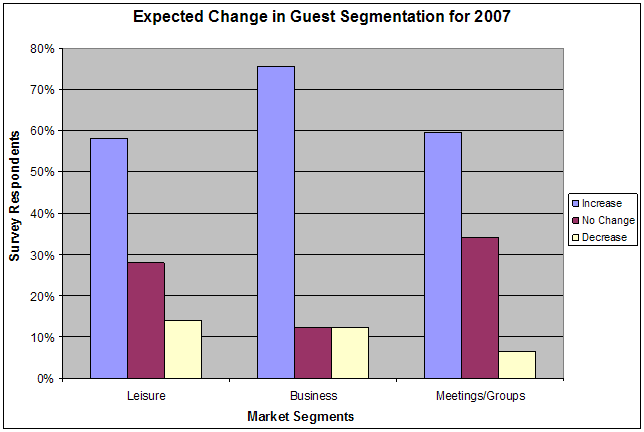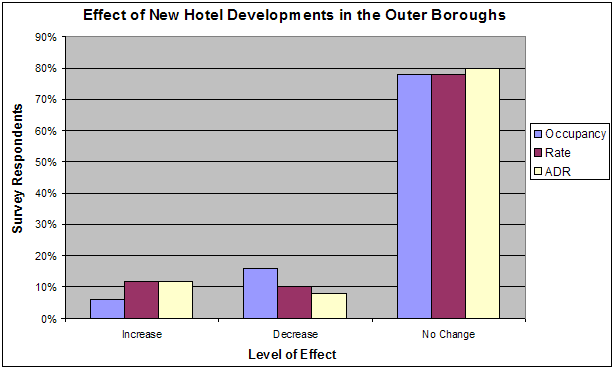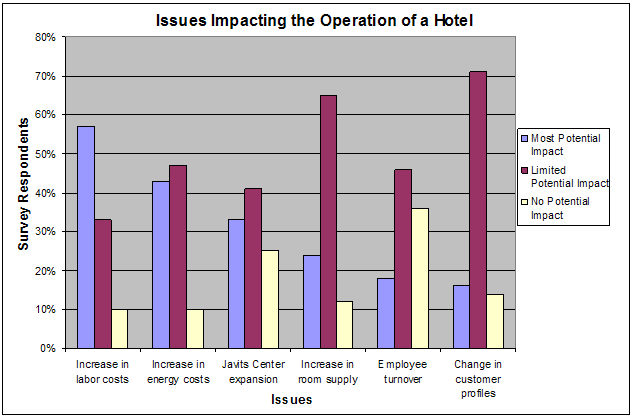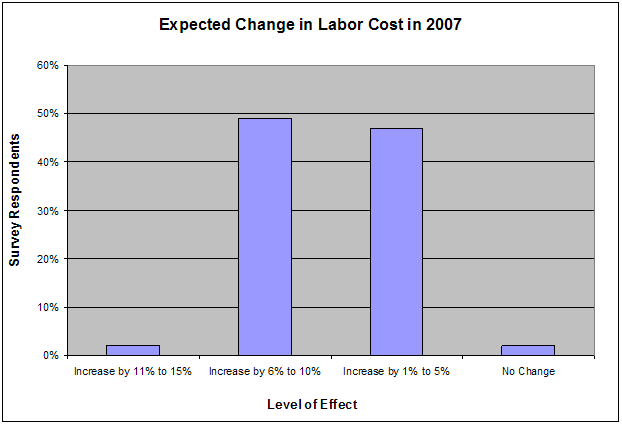| |
Stephen Rushmore
President and Founder, HVS Hospitality Services |
| |
| |
| |
Michael R. Bloomberg
Mayor of the City
of New York |
| |
| |
| |
Jonathan M. Tisch
Chairman & CEO, Loews Hotels
Chairman, NYC
& Company |
| |
| |
| |
George Fertitta
CEO, NYC
& Company |
| |
| |
| |
Lalia Rach, Ed.D.
Associate Dean, The
Preston Robert Tisch Center for Hospitality, Tourism, and Sports
Management |
| |
| |
| |
Mark Lomanno
President, Smith
Travel Research |
| |
| |
| |
Joseph Spinnato
President & CEO,
Hotel Association
of NYC |
| |
| |
| |
| Donna Quadri-Felitti
President, HSMAI Big Apple Chapter |
| |
|
|
Survey of the Members of the Hotel Association of New York City and the Big Apple Chapter of Hotel Sales & Marketing Association International
The graduate students of New York University's Preston Robert
Tisch Center for Hospitality, Tourism, and Sports Management
conducted an online survey of the members of the Hotel
Association of New York City (HANYC) and the Big Apple Chapter
of Hotel Sales & Marketing Association International (HSMAI).
The purpose of the survey is to gain perspective relative to the
hotel market in New York City. Of the 58 responses, there were
51 usable surveys, representing a 10% survey return rate; the
findings outlined in this report are based on the usable
surveys.
Mark Lomanno
President, Smith
Travel Research
New York City hotels experienced another very strong
year in 2006, as occupancy levels remained high, at over 82 percent.
This historically high level of performance was punctuated by very
modest growth in new room supply and stable room night demand. Over
the past several years, New York City hotels have benefited from
actual declines in room supply. In fact, the recent additions to
supply have only brought the number of rooms in the city to levels
that existed early in the decade. With supply growth stagnant during
the current economic boom, room night demand has surged, driving
occupancies up to these very high levels.
With market-wide occupancy at these levels, hoteliers
are have been able to raise room rates fairly aggressively over
the past three years. For the past 30 months, annualized room rate
growth has exceeded 10 percent, resulting in double-digit RevPAR
growth for an even longer period of time. Needless to say, this
has created a very favorable market for hotel operators and owners.
With barriers to entry remaining very high, the long-term outlook
for new additions to room supply remains very benign. In the absence
of an economic downturn, demand is likely to remain robust, which
is almost certain to create an operating environment in which hotel
operators in the city will be able to maintain their aggressive
pricing strategy of the past several years.
The New York City market continues its strong performance, and
the hotel professionals that work in the city share the
optimism. Over half of the hotels represented by the survey
respondents had an increase of at least 10% in their Gross
Operating Margin (GOM) from 2005 to 2006. The GOM figures for
2007 seem promising as well. The majority of the respondents
expect their average daily rate (ADR) to be at least 10% higher
in 2007 than in 2006, and nearly 60% believe that occupancy will
change only slightly. Even with the expected increase in room
supply, the market remains optimistic. Over half of the
respondents indicated that the increase in room supply by 2009
will decrease the occupancy of the NYC market as a whole, but
feel that their own properties, neighborhoods, and competitive
set will not be affected. However, they do believe that as rates
continue to rise, the meetings/groups segment (46%) and the
leisure segment (44%) are most likely to choose a hotel outside
Manhattan, with Hoboken/Jersey City receiving most of the
overflow business.
Details of the findings follow:
- Most of the respondents work in the area of sales and marketing
(31%) or operations (27%).
- Survey respondents categorized their hotel market segments
as luxury (18%), upper upscale (31%), upscale (18%), mid-scale
with food and beverage (14%), mid-scale without food and beverage
(16%), and economy (4%).
- Sixty-six percent of the respondents work in properties located
in the Midtown area: Midtown West (45%) and Midtown East (22%).
- More than half of the respondents indicated that 41% of their
guests were from the business segment. Additionally, 51% of
the respondents specified the leisure segment made up over 31%
of their guests, while 37% indicated that over 21% of their
business was meetings/groups.
- The majority of the respondents expected increases in all
customer segments. Seventy-six percent of the respondents expected
a higher growth rate in business travel over the leisure and
meetings/groups segments. Business travel was also the fastest-growing
customer segment in last year�s survey.

- Approximately half of all respondents stated that greater
than 40% of their business segment is repeat business.
- Fifty-two percent of the respondents will increase their marketing
efforts toward the leisure segment. Fifty-three percent will
not change their business segment marketing efforts. For the
meetings/groups segment, 45% will not change, while another
45% of respondents will increase their marketing effort toward
this segment.
- "Lifestyle" branding, environmental sustainability,
family travel, and emerging technology are impacting the marketing
strategies of the majority of the respondents. Forty one percent
reported �lifestyle� branding having the greatest effect, while
49% considered environmental sustainability as having "little
to no effect."

- Nearly 86% of all the survey respondents expected that their
occupancy will increase by year-end. Thirty-nine percent expected
that it will increase between 0% and 3%, while 20% believe it
will decrease by 0% and 3% at most.
- With regard to ADR, the majority of the respondents expect
their ADR to be at least 10% higher than in 2006.
- While 30% of the respondents expect their RevPAR (rooms revenue
per available room) to increase between 7% and 10%, 40% of the
respondents expect an increase of higher than 10%.
- The majority of the respondents agreed that the rapid increase
in rate will peak by year-end.

- While 67% of the respondents expect no change in their room
inventories, 16% of the respondents expect a reduction in room
inventory over the next 12 months.
- Nearly half of the respondents indicated that the anticipated
increase in room supply expected by 2009 will cause a decrease
in the NYC market occupancy as a whole, but feel that their
own properties, neighborhoods, and competitive set will not
be affected.

- In terms of rate, the majority of respondents feel that the
increase in room supply will increase rates in their neighborhoods,
as well as the NYC market, but not in their competitive set.

- According to survey respondents, 74% will be changing amenities,
and 72% will be renovating their rooms to compete with the increasing
supply of hotel rooms.
- Approximately 88% of respondents feel that favorable exchange
rates will increase travel to NYC, both domestic and international.
- As rates continue to rise, 46% of the survey respondents feel
that the meetings/groups segment is the most likely segment
to choose a hotel outside Manhattan, followed by the leisure
(44%) and business (10%) segments.
- Forty-two percent of respondents feel that Hoboken/Jersey
City will receive most of the overflow business from Manhattan
in 2007, similar to the 2006 survey results. Eighteen percent
feel Brooklyn will receive most of the overflow, followed by
Queens, including Long Island City (12%), LGA (10%), JFK (10%),
and other areas in New Jersey (8%).
- Over three-fourths of the respondents feel that the emergence
of new hotel developments occurring in the outer borough areas
(including New Jersey) will not affect their hotels in terms
of occupancy or rate.

- Ninety percent of the respondents believe that price-sensitivity
is the most influential factor for potential guests choosing
a hotel outside Manhattan, an increase of approximately 30%
from the 2006 survey. Seventy-eight percent of respondents feel
that the lack of available rooms will influence travelers to
stay outside Manhattan, up about 45% from the 2006 survey.
- Seventy-one percent of respondents expect the price-sensitive
regional market (PA, CT, upstate NY, and MA) will choose a lower-category
hotel, while 37% feel that they will stay in satellite markets,
such as Hoboken and Queens/Long Island.
- Sixty-nine percent of respondents feel that newly built limited-service
hotels will mainly accommodate leisure guests, up about 19%
from the 2006 survey. Twenty-nine percent of respondents feel
that business guests will be accommodated by limited-service
hotels followed by meetings/groups (2%).
- Seventy-eight percent of the respondents feel that the emergence
of new brands, such as NYLO and aloft, will not affect the occupancy
of their hotels.
- As found in the 2005 and 2006 surveys, labor costs remain
an important issue for hotels. Fifty-seven percent of the survey
respondents still considered labor costs as having the most
potential impact. Forty-three percent feel that an increase
in energy costs will have the most potential impact on their
hotels� operation through 2008, followed by the Javits Center�s
expansion (33%), increase in room supply (24%), employee turnover
(18%), and changes in customer profiles (16%).

- Seventy percent of respondents expect an increase in their
international leisure travelers over 2006. Respondents also
stated that they expect increases in international business
travelers (59%) and international meetings/groups (28%).
- Approximately 90% of the survey respondents indicated that
Europe is the strongest generator of international travelers
to New York City hotels, up from the 2006 survey, with the United
Kingdom being the primary market that provides the international
travelers.
- Fifty-three percent of the hotels represented by the survey
respondents had an increase of at least 10% in their Gross Operating
Margin from 2005 to 2006.

- Ninety-eight percent of the survey respondents expected labor
costs to increase; almost 50% believe that it will be between
6% and 10%.

Further Analysis
Due to respondent profiling, the NYU student group was able to data-mine the
differences of opinions between the various hotel professionals represented in
the survey. These analyses are meant to shed light on the different perspectives
of the New York City hotel market.
Sales and Marketing Perspective
- Although Sales and marketing make up 31% of the sample population,
they accounted for half of the respondents that expect over 41%
of their business to be repeat business.
- Sales and marketing respondents consider environmental
sustainability as a trend that will have a greater effect on
their marketing strategies than family travel and emerging
technology.
- Although the sales and marketing respondents tend to be more
conservative in their 2007 estimates of occupancy, ADR, and
RevPAR, they are the most optimistic department. Most of them
anticipate an increase in occupancy, even through approximately
10% to 15% more rooms are expected in the New York City market
by 2009.
- Fifty-three percent of the sales and marketing respondents expect
Hoboken/Jersey City to receive the most overflow business in 2007,
compared to just 37% of all other respondents.
- Change in customer profile is seen as an issue with much
more potential impact by the respondents with job functions in
sales and marketing.
- In contrast to the rest of the survey respondents, more
sales and marketing professionals expect the number of
international travelers to increase.
Upper-Class Perspective (Luxury, Upper Upscale and Upscale)
- At least 54% of the respondents representing upper-class
hotels consider that their demand will increase in all market
segments.
- Two-thirds of upper-class hotels expect their occupancy to
change by only 0% to 3%, but 40% of them expect their ADR and
RevPAR to increase by at least 10%.
- With an anticipated increasing supply of rooms, upper-class
hotels plan to renovate and upgrade amenities to stay
competitive.
- Fifty-six percent of the respondents that work in
upper-class hotels believe that the increase in rate will peak
in six months or less, while 53% of all respondents (excluding
upper class) agree that it will take until year-end.
- Close to 82% of all respondents representing upper-class
hotels believe that the price-sensitive regional markets will
choose a lower-category Manhattan hotel rather than stay in a
satellite market.
- Europe was the strongest generator of international guests
to nearly all (94%) upper-class hotels represented in the
survey.
- In comparison to 2005, the Gross Operating Margin of
practically all the upper-class hotels represented by the survey
respondents increased in 2006.
Midtown West Perspective
- The Midtown West market is confident about its future
occupancy. Fifty-seven percent of these respondents believe
occupancy in their neighborhoods will increase,even though 10%
to 15% more rooms are expected to be added to the NYC market by
2009. A mere 7% of survey respondents representing the other
neighborhoods believe that their properties� occupancies will
increase even with the influx of rooms.
- Ninety-one percent of Midtown West respondents will change
their amenities to compete with the increasing supply of hotel
rooms.
- Sixty-five percent of these survey respondents expect the
meetings/groups segment to choose a hotel outside Manhattan as
rates continue to rise.
- Over 65% of the Midtown West respondents believe that the
price-sensitive regional market will only make day trips, rather
than select a lower-category hotel as was indicated by the
upper-class hotel respondents.
- All respondents working in Midtown West feel that the Javits
Center expansion will have a potential impact on their property.
Summary
It is interesting to see how some issues are given lesser or greater
importance depending on job function and hotel neighborhood location
in NYC. Upper-class hotels believe that the increases in rate will
peak in six months or less, while the rest agree that it will take
until year-end. The Midtown West market is optimistic about its
future occupancy, with respondents believing that occupancy in their
neighborhood will increase even though the NYC market plans 10% to
15% additional rooms. Sales and marketing is the most positive
department, expecting an increase in occupancy, even with added
hotel rooms by 2009. However, they remain conservative in their
estimates of occupancy, ADR, and RevPAR.
<<Previous
Next
>>
|
|



